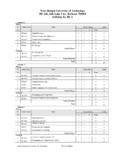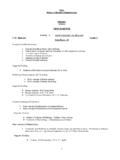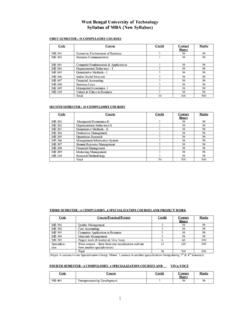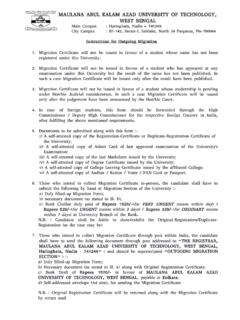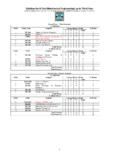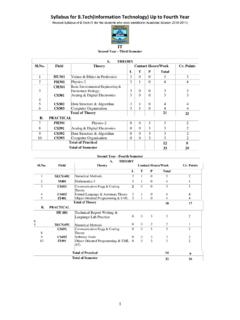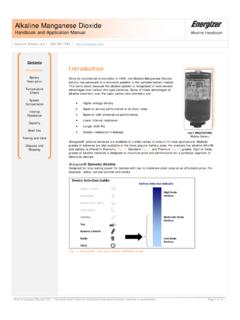Transcription of Revised Syllabus to be implemented from the Academic Year ...
1 1 Revised Syllabus to be implemented from the Academic Year 2010 (for the new batch only) First Year First Semester A. THEORY Sl. No. Field Theory Contact Hours/Week Credit Points L T P Total 1 HU101 ENGLISH LANGUAGE & TECHNICAL COMMUNICATION 2 0 0 2 2 2 PH101/CH101 Chemistry 1 (Gr B) / Physics 1 (Gr A) 3 1 0 4 4 3 M101 Mathematics 1 3 1 0 4 4 4 ES101 Basic Electrical & Electronic Engineering 1 (GrA+GrB) 3 1 0 4 4 5 ME101 Engg. Mechanics 3 1 0 4 4 Total of Theory 18 18 B. PRACTICAL 6 PH191/CH191 Chemistry 1 (Gr B)/ Physics 1 (Gr A) 0 0 3 3 2 7 ES191 Basic Electrical & Electronic Engineering 1 0 0 3 3 2 8 ME191/192 Engg Drawing & Computer Graphics (Gr B) / Workshop Practice (Gr A) 1 0 3 4 3 Total of Practical 10 7 C.
2 SESSIONAL 9 HU181 Language Laboratory 0 0 2 2 1 10 XC181 Extra Curricular Activities(NSS/NCC/NSO etc) 0 0 2 2 1 Total of Sessional 4 2 Total of Semester 32 27 Physics based branches divided in to Gr-A & Gr-B, Gr-A= Phys in sem-I , Gr-B = Phys in sem-II; Chemistry based branches Physics in sem-1. Group division: Group-A: Chemistry based subjects: [Bio Technology, Food Technology, Leather Technology, Textile Technology, Ceramic Technology, Chemical Engineering and any other Engineering that chooses to be Chemistry based] + Physics based subjects: [Mechanical Engineering, Production Engineering, Civil Engineering, Automobile Engineering, Marine Engineering, Apparel Production Engineering, Computer Science & Engineering, Information Technology.]
3 ] Group-B: All Physics based subjects which are also Electrical & Electronics based [Electrical Engineering, Electronics & Communication Engineering, Applied Electronics & Instrumentation Engineering, Power Engineering, Electrical & Electronics Engineering, Bio Medical Engineering, Instrumentation & Control Engineering] 2 First Year Second Semester A. THEORY Sl. No. Field Theory Contact Hours/Week Credit Points L T P Total 1 CS201 Basic Computation & Principles of Computer Programming 3 1 0 4 4 2 PH201/CH201 Physics 1(Gr B) / Chemistry 1(Gr A) 3 1 0 4 4 3 M201 Mathematics 2 3 1 0 4 4 4 ES201 Basic Electrical & Electronic Engineering II 3 1 0 4 4 5 ME201 Engineering Thermodynamics & Fluid Mechanics 3 1 0 4 4 Total of Theory 20 20 B.
4 PRACTICAL 7 CS291 Basic Computation & Principles of Computer Programming 0 0 3 3 2 8 PH291/CH291 Physics 1 (Gr B) /Chemistry 1 (Gr A) 0 0 3 3 2 9 ES291 Basic Electrical & Electronic Engineering II 0 0 3 3 2 10 ME291/292 Workshop Practice (Gr B) / Basic Engg Drawing & Computer Graphics (Gr A) 1 0 3 4 3 Total of Practical 13 9 Total of Semester 32 29 Group-A Group-B 1st Sem Physics I; Workshop Practice Chemistry 1; Engg Drawing & Computer Graphics 2nd Sem Chemistry 1; Engg Drawing & Computer Graphics Physics I; Workshop Practice 3 Syllabus First Semester Theory HU English PAPER CODE: HU 101 CONTACT: 2L CREDIT: 2 PAPER NAME: ENGLISH LANGUAGE & TECHNICAL COMMUNICATION Guidelines for Course Execution: Objectives of the Course: This Course has been designed 1.
5 To impart advanced skills of Technical Communication in English through Language Lab. Practice Sessions to 1st Semester UG students of Engineering &Technology. 2. To enable them to communicate confidently and competently in English Language in all spheres. Desired Entry Behaviour: The students must have basic command of English to Talk about day to day events and experiences of life. Comprehend Lectures delivered in English. Read and understand relevant materials written in English. Write grammatically correct English. Strategies for Course Execution: 1. It is a Course that aims to develop Technical Communication Skills. It is, therefore, Lab- based and practical in orientation.
6 Students should be involved in Practice Sessions. 2. The content topics should be conveyed through real life situations. Lecture classes should be conducted as Lecture cum Tutorial classes. 3. Keeping in view the requirements of students, the teachers may have to prepare some learning aids task materials. 4. Some time should be spent in teaching stress and intonation. 5. In teaching Speaking skill, emphasis should be on clarity, intelligibility, fluency,( as well as accepted pronunciation). 6. Micro Presentation and Group Discussion Sessions should be used for developing Communicative Competence 7.
7 The Language Lab, device should be used for giving audio visual inputs to elicit students responses by way of Micro Presentation, Pair Conversation, Group Talk and Class Discussion. 8. The teacher must function as a creative monitor in the Language Lab for the following: A. Developing Listening Comprehension Skill; 1. Developing Listening Comprehension through Language Lab Device 2. Developing sub skills of the Listening Skill by Conversational Practice Sessions 3. Focusing on intelligent and advanced Listening Sessions Seminars, Paper Presentation, Mock Interviews etc. 4. Conducting Conversational Practice: Face to Face & Via Media (Telephone, Audio, Video + Clips) B.
8 Developing Speaking Competence: a) Helping students in achieving clarity and fluency ; manipulating paralinguistic features of speaking (voice modulation ,pitch , tone stress , effective pauses ) Conducting Task oriented interpersonal ,informal and semiformal Speaking / Classroom Presentation 4 b) Teaching strategies for Group Discussion Teaching Cohesion and Coherence Teaching effective communication & strategies for handling criticism and adverse remarks Teaching strategies of Turn- taking, effective intervention, kinesics (use of body language) and courtesies and all componentss of softskills. C. Developing Reading Comprehension Skill: a) Developing Reading Skill through Non Technical (Literary) Texts (See Recommended Book 5) 1.
9 The Thief by Ruskin Bond 2. The Open Window by Saki 3. Marriage is a private Affair by Chinua Achebe 4. The Moon in the Earthen Pot by Gopini Karunakar b) Developing Reading Skill through Radio Commentary, Technical Texts and Case Studies (Refer to Recommended Book 1.) * Freedom by G. B. Shaw (Radio Commentary) a) Guiding students for Intensive & Extensive Reading( See Recommended Book 1 ) D. Developing Writing Competence: a) Teaching all varieties of Technical Report, Business Letters and Job Application (Expressing Ideas within restricted word limit through paragraph division, Listing Reference Materials through Charts , Graphs ,Tables and Diagrams); b) Teaching correct Punctuation & Spelling, Semantics of Connectives, Modifiers and Modals, variety of sentences and paragraphs c) Teaching Organizational Communication: Memo, Notice, Circular, Agenda / Minutes etc.
10 Syllabus DETAILED OUTLINES A. ENGLISH LANGUAGE GRAMMAR: 5L Correction of Errors in Sentences Building Vocabulary Word formation Single Word for a group of Words Fill in the blanks using correct Words Sentence Structures and Transformation Active & Passive Voice Direct & Indirect Narration (MCQ Practice during classes) B. READING COMPREHENSION: Strategies for Reading Comprehension 1L Practicing Technical & Non Technical Texts for Global/Local/Inferential/Referential comprehension; 3L Pr cis Writing C.
